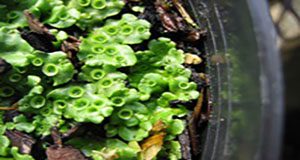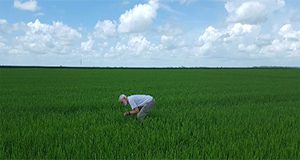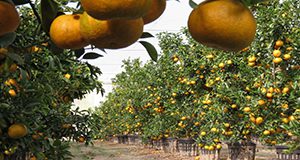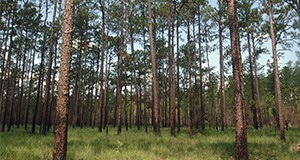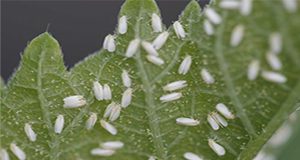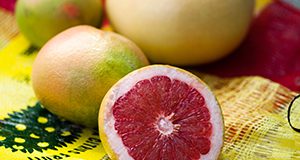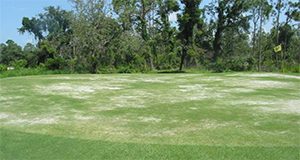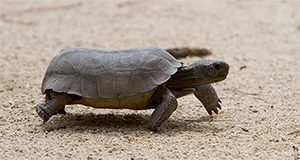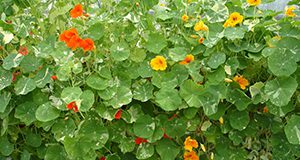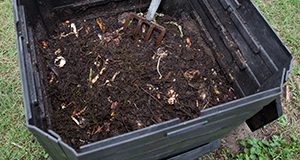Liverwort is a common weed problem in production nurseries and greenhouses. This article has been written to help growers identify liverwort, understand its biology, and inform them of ways this weed can be managed in their operation. Written by Chris Marble, Marc S. Frank, Dail Laughinghouse, Shawn Steed, and Nathan Boyd, and published by UF’s Environmental Horticulture Department, September 2017.
http://edis.ifas.ufl.edu/ep542
Category: Agriculture
What Is the ENSO Climatology Tool?
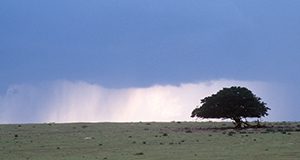 On a global scale, periodic anomalies in sea surface temperatures coupled with shifts in atmospheric pressure and winds, such as those associated with the El Niño Southern Oscillation (ENSO), can have profound impacts on weather conditions. ENSO affects atmospheric circulation patterns well into the midlatitudes and is the leading driver of seasonal climate variability in the United States. Tremendous advances have been made in predicting the occurrence of ENSO events with confidence three to six months in advance. This 5-page fact sheet discusses the ENSO climatology tool as well as possible challenges. Written by Caroline Staub, Clyde Fraisse, Eduardo Gelcer, and Daniel Dourte, and published by the UF Department of Agricultural and Biological Engineering, March 2017.
On a global scale, periodic anomalies in sea surface temperatures coupled with shifts in atmospheric pressure and winds, such as those associated with the El Niño Southern Oscillation (ENSO), can have profound impacts on weather conditions. ENSO affects atmospheric circulation patterns well into the midlatitudes and is the leading driver of seasonal climate variability in the United States. Tremendous advances have been made in predicting the occurrence of ENSO events with confidence three to six months in advance. This 5-page fact sheet discusses the ENSO climatology tool as well as possible challenges. Written by Caroline Staub, Clyde Fraisse, Eduardo Gelcer, and Daniel Dourte, and published by the UF Department of Agricultural and Biological Engineering, March 2017.
http://edis.ifas.ufl.edu/ae522
Additional Nutritional Considerations for Preconditioning Beef Calves
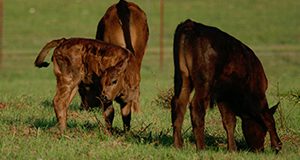 Feed ingredient selection is not the only factor to consider during a preconditioning process. Recent studies demonstrated that diet composition and frequency of supplementation can have positive or negative effects on calf performance during preconditioning. This 7-page fact sheet focuses on the ways beef cattle producers can modify the nutritional composition of diets and frequency of concentrate supplementation to optimize growth and immunity of preconditioning beef calves or prevent detrimental effects. Written by Philipe Moriel, and published by the UF Department of Animal Sciences, September 2017.
Feed ingredient selection is not the only factor to consider during a preconditioning process. Recent studies demonstrated that diet composition and frequency of supplementation can have positive or negative effects on calf performance during preconditioning. This 7-page fact sheet focuses on the ways beef cattle producers can modify the nutritional composition of diets and frequency of concentrate supplementation to optimize growth and immunity of preconditioning beef calves or prevent detrimental effects. Written by Philipe Moriel, and published by the UF Department of Animal Sciences, September 2017.
http://edis.ifas.ufl.edu/an334
2012–2016 On-Farm Evaluation of Fungicide Programs for Peanut Disease Control in Hamilton County, Florida
This seven-page fact sheet includes a summary of various fungicide spray programs for fungal disease control of early leaf spot, late leaf spot, and white mold/stem rot of peanut in 2012-2016 on-farm trials in Hamilton County. Written by K.W. Wynn, N.S. Dufault, and R.L. Barocco and published by the Plant Pathology Department.
http://edis.ifas.ufl.edu/pp334
Rice Water Weevil (Coleoptera: Curculionidae) Distribution and Management in Florida
The rice water weevil, Lissorhoptrus oryzophilus Kuschel, is the most widely distributed and destructive pest of rice in the United States. This 4-page fact sheet written by Matthew T. VanWeelden and Ron Cherry and published by the Department of Entomology and Nematology provides a description of the rice water weevil, its distribution in the state of Florida, methodology for scouting, and options for managing this pest in commercial rice fields.
http://edis.ifas.ufl.edu/in1167
Citrus Under Protective Screen (CUPS) Production Systems
Citrus can be grown under protective screen structures for fresh fruit production in order to completely exclude the Asian citrus psyllid and therefore huanglongbing disease (HLB, citrus greening). The benefits of eliminating HLB are immediate and include rapid, normal tree growth, higher yields of quality fruit, negligible fruit drop, and uncomplicated fertilizer and irrigation requirements. Because CUPS is a relatively new citrus production system with new challenges, current guidelines are preliminary and undergoing constant refinement through research. This summary of concepts, progress, and tentative recommendations from the first three years of CUPS research in Florida written by A. W. Schumann, A. Singerman, A. L. Wright, and R. S. Ferrarezi and published by the Horticultural Sciences Department was condensed from a comprehensive CUPS Quick Start Guide that will be published and updated on the UF/IFAS EDIS website.
http://edis.ifas.ufl.edu/hs1304
Florida's Forest Stewardship Program: An Opportunity to Manage Your Land for Now and the Future
The Forest Stewardship Program encourages landowners to manage their lands for multiple natural resources, increases public awareness of the importance of Florida’s forestlands, and improves cooperation among natural resource agencies and organizations to meet Florida’s forest resource conservation and management needs. This three page fact sheet written by Mary Duryea, Deborah McGrath, Chris Demers, and Anthony Grossman and published by the School of Forest Resources and Conservation explains the program and its benefits and describes how to become a forest steward.
http://edis.ifas.ufl.edu/fr408
Establishment and Production Costs for Peach Orchards in Florida: Enterprise Budget and Profitability Analysis
While the Florida peach industry is small, it has experienced significant growth in recent years. This 20-page article written by Ariel Singerman, Marina Burani-Arouca, and Mercy Olmstead and published by the Food and Resource Economics Department summarizes the establishment and production costs as well as the potential profitability of a peach orchard in Florida. It includes an enterprise budget, estimates of potential revenue and undiscounted cash flows for different combinations of prices and yields, and an investment analysis. The information in this article should be relevant to both current and potential Florida peach growers.
http://edis.ifas.ufl.edu/fe1016
Eight New Potato Variety Trials Spotlights
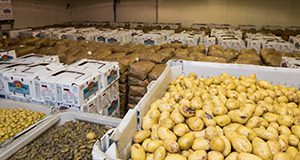
The following eight new potato variety trials spotlights explain the results of the trials and describe the different cultivars. They are published by the Horticultural Sciences Department.
-
HS1293 University of Florida Potato Variety Trials Spotlight: ‘Adirondack Blue’ by Rodrick Z. Mwatuwa, Christian T. Christensen, Pam Solano, and Lincoln Zotarelli
http://edis.ifas.ufl.edu/hs1293 -
HS1294 University of Florida Potato Variety Trials Spotlight: ‘Fabula’ by Rodrick Z. Mwatuwa, Chrsitian T. Christensen, Pam Solano, and Lincoln Zotarellia
http://edis.ifas.ufl.edu/hs1294 -
HS1295 University of Florida Potato Variety Trials Spotlight: ‘Peter Wilcox’ by Rodrick Z. Mwatuwa, Christian T. Christensen, Pam Solano, Kathleen G. Haynes, and Lincoln Zotarelli
http://edis.ifas.ufl.edu/hs1295 -
HS1296 University of Florida Potato Variety Trials Spotlight: ‘Yukon Gold’ by Rodrick Z. Mwatuwa, Christian T. Christensen, Pam Solano, and Lincoln Zotarelli
http://edis.ifas.ufl.edu/hs1296 -
HS1297 University of Florida Potato Variety Trials Spotlight: ‘LaChipper’ by Rodrick Z. Mwatuwa, Christian T. Christensen, Pam Solano, and Lincoln Zotarelli
http://edis.ifas.ufl.edu/hs1297 -
HS1298 University of Florida Potato Variety Trials Spotlight: ‘Harley Blackwell’ by Rodrick Z. Mwatuwa, Christian T. Christensen, Pam Solano, Kathleen G. Haynes, and Lincoln Zotarelli
http://edis.ifas.ufl.edu/hs1298 - HS1299 University of Florida Potato Variety Trial Spotlight: ‘Goldrush’ by Rodrick Z. Mwatuwa, Christian T. Christensen, Pam Solano, and Lincoln Zotarelli http://edis.ifas.ufl.edu/hs1299
-
HS1300 University of Florida Potato Variety Trials Spotlight: ‘French Fingerling’ by Rodrick Z. Mwatuwa, Christian T. Christensen, Pam Solano, and Lincoln Zotarelli
http://edis.ifas.ufl.edu/hs1300
Whitefly (Bemisia tabaci) Management Program for Ornamental Plants
Silverleaf whitefly is one of the most notorious invasive arthropods worldwide. It feeds on more than 900 plant species and vectors over 100 plant-damaging viruses. This 10-page fact sheet written by Vivek Kumar, Cristi Palmer, Cindy L. McKenzie, and Lance Osborne and published by the Department of Entomology and Nematology provides management recommendations, strategies for detection and scouting, and advice about control measures for this pernicious pest.
http://edis.ifas.ufl.edu/in1171
Cost of Production for Fresh Grapefruit Grown in Indian River, 2015/16
This 4-page article written by Ariel Singerman and published by the Food and Resource Economics Department presents the cost of production per acre for growing fresh grapefruit in the Indian River region during 2015/2016, based on a survey of growers conducted at the Indian River Citrus League production committee meeting in mid-July 2016. The cost estimates do not represent any individual operation; rather, their purpose is to serve as a benchmark for the industry. Typical users of these estimates include growers, consultants, property appraisers, and researchers.
http://edis.ifas.ufl.edu/fe1011
Nematode Management in Residential Lawns
Plant-parasitic nematodes are among the least understood and most difficult pests to manage on turfgrass in Florida. They are very small, and most can only be seen with the aid of a microscope. They use a stylet to puncture plant cells, to inject digestive juices into them, and to ingest plant fluids. The most reliable way to determine whether plant-parasitic nematodes are involved in a turf problem is to have a nematode assay conducted by a professional nematode diagnostic lab. This 6-page fact sheet was written by William T. Crow, and published by the UF Department of Entomology and Nematology.
http://edis.ifas.ufl.edu/ng039
Genetic Selection for Gaits in the Horse
Quality and cadence of various locomotion patterns are extremely valuable traits in horses. Breeds like the Tennessee Walking Horse, Florida Cracker Horse, Mangalarga marchador, and Icelandic Pony are prized and selected for unique intermediate-speed locomotion patterns. What if genetics could help us unravel and better select for the locomotion patterns of our horses? This 4-page fact sheet discusses the connection between locomotion patterns and genetics, DMRT3 and locomotion in the horse, improvement of understanding of the gene function of DMRT3, and current as well as future applications. Written by Laura Patterson Rosa, Carissa Wickens, and Samantha A. Brooks, and published by the UF Department of Animal Sciences, May 2017.
http://edis.ifas.ufl.edu/an332
The Value of Private Non-Industrial Forestland for Wildlife Species Conservation
Animals in Florida provide a variety of benefits to people, from recreation (fishing, hunting, or wildlife viewing) to protection of human life and property (oysters and corals provide reef structures that help protect coasts from erosion and flooding). By measuring the economic value of these benefits, we can assign a monetary value to the habitats that sustain these species and assess the value that is lost when development or other human-based activities degrade animal habitat. This 5-page fact sheet written by Shelly Johnson, Timm Kroeger, Josh Horn, Alison E. Adams, and Damian C. Adams and published by the School of Forest Resources and Conservation presents the results of a study that assessed the value of protecting five animal species in Florida and showed the economic value of protecting animal habitat.
http://edis.ifas.ufl.edu/fr405
Powdery Mildew on Nasturtium in South Florida
Powdery mildew, which is caused by the fungus Leveillua rutae (syn. Oidiopsis haplophylli) on nasturtium (Tropaeolum majus L.), was found in southwest Florida for the first time in 2015 (Fayette et al. 2016). This two-page fact sheet describes the pathogen, its symptoms, and how to manage it. Written by Pamela D. Roberts, Katherine E. Hendricks, Francesco Di Gioia, Joubert Fayette, and Monica Ozores-Hampton and published by the Plant Pathology Department.
http://edis.ifas.ufl.edu/pp335
Tools for Evaluating Soil Health
Soil health is a term synonymous with soil quality. It refers to the chemical, biological, and physical characteristics that influence a soil’s ability to function sustainably and to satisfy the needs of humans, support plants, and cycle elements, water, and energy between earth systems. This four-page fact sheet identifies ways to evaluate soil health. Written by Jehangir H. Bhadha, Jay Capasso, Robert S. Schindelbeck, and Allan R. Bacon and published by the Department of Soil and Water Sciences.
http://edis.ifas.ufl.edu/ss657
Herbicide Residues in Manure, Compost, or Hay
When purchasing compost, it is important to understand that some manure-based products can contain herbicide residues that can affect the growth of certain plants. Manure from animals that have been fed forage treated with aminopyralid or other closely related herbicides, such as clopyralid or picloram, can be contaminated with these herbicides, which severely restrict the growth of legume and solanaceous crops and other broadleaf plants. This 3-page fact sheet discusses aminopyralid, compost, questions to ask when purchasing bulk compost or mulch, conducting a bioassay, aminopyralid injury symptoms, and steps to consider if contaminated manure or compost has been added to a garden or field site. Written by Jason Ferrell, Peter Dittmar, and Brent Sellers, and published by the UF Agronomy Department, May 2017.
http://edis.ifas.ufl.edu/ag416
Yield Mapping Hardware Components for Grains and Cotton Using On-the-Go Monitoring Systems
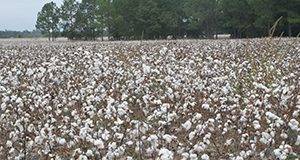 This 12-page fact sheet discusses yield mapping benefits, grain yield flow sensors, grain moisture sensors, cotton yield flow sensors, differential GNSS receivers, ground speed sensors, header position sensors, computer displays, yield calculation and calibration, and costs of yield mapping hardware components. Written by Rebecca Barocco, Won Suk Lee, and Garret Hortman, and published by the UF Department of Agricultural and Biological Engineering, February 2017.
This 12-page fact sheet discusses yield mapping benefits, grain yield flow sensors, grain moisture sensors, cotton yield flow sensors, differential GNSS receivers, ground speed sensors, header position sensors, computer displays, yield calculation and calibration, and costs of yield mapping hardware components. Written by Rebecca Barocco, Won Suk Lee, and Garret Hortman, and published by the UF Department of Agricultural and Biological Engineering, February 2017.
http://edis.ifas.ufl.edu/ae518
Galloping into the Future: Genetic Tips and Tools for the Horse Owner
This 4-page fact sheet discusses the equine genome, determining the genotype of a horse, breeding for certain traits, and the future of genetic tools. Written by Laura Patterson Rosa, Carissa Wickens, and Samantha A. Brooks, and published by the UF Department of Animal Sciences, May 2017.
http://edis.ifas.ufl.edu/an333
Citrus Fruit Blemishes and Decay Caused by Fungi and Bacteria
This new one-page citrus identification fact sheet illustrates different blemishes from fungi and bacteria that affect citrus. Written by Mark A. Ritenour, Jamie D. Burrow, Megan M. Dewdney, and John Zhang and published by the Horticultural Sciences Department.
http://edis.ifas.ufl.edu/hs1291
